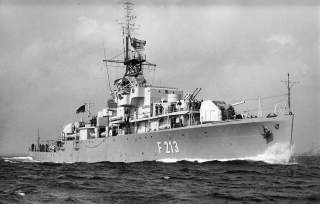How a Little British Frigate Took on Communist China—and Won
It was too small a ship for such a big war.
On the night of July 30, the Amethyst set sail, tailing close behind a communist steamer. Lacking charts or recognition signals, Kerans hoped the other ship would unknowingly guide them through checkpoints and sandbars.
The frigate was soon spotted. The communists eventually opened fire, but instead hit their own steamer and another vessel. Amazingly, despite no charts or guide boats, Amethyst managed to avoid obstacles, booms, hostile ships and the guns of Woosung fort at the mouth of the Yangtze.
The little frigate had made it, though not without cost. The British lost twenty-four sailors from the Amethyst and the rescue ships. The communists took a petty revenge by persecuting Sam Leo, Kerans' Chinese interpreter (equally petty, the British Treasury balked at paying a pension to his widow). Simon the cat returned home, where he died in a cage under British animal quarantine laws. Simon was later awarded the Dickin Medal, the animal equivalent of the Victoria Cross.
For a time, HMS Amethyst achieved fame. But a sort of immortality would come from the 1957 movie "The Yangtze Incident" (also known as "Battle Hell"). Amethyst would be the star in its own movie! But during filming, a special effects explosion blew a hole in the hull and her sister ship—HMS Magpie—doubled for her.
As the movie was being released into theater, the frigate met its final enemy. In January 1957, HMS Amethyst was scrapped.
For further information:
Yangtze Showdown: China and the Ordeal of HMS Amethyst - by Brian Izzard
“The Yangtze Incident” (Battle Hell) -1957 film
Michael Peck is a contributing writer for the National Interest. He can be found on Twitter and Facebook.
Image: Wikimedia Commons

